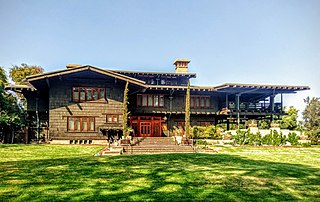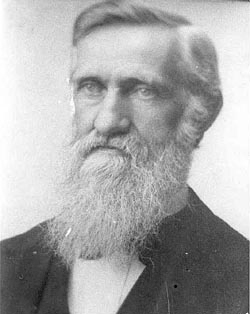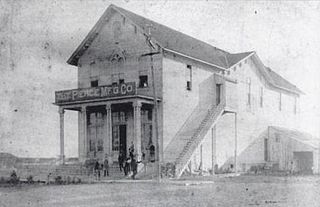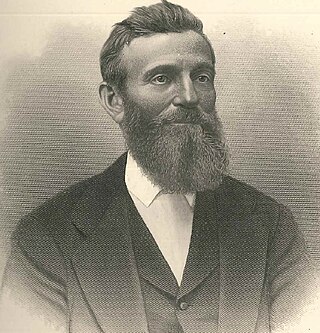
Caryville is a town in Washington County, Florida, United States located along the Choctawhatchee River. The population was 411 at the 2010 census.

Manistee is a city in the U.S. state of Michigan. Located in southwestern Manistee County, it is part of the northwestern Lower Peninsula. Manistee is the county seat of Manistee County, and its population was 6,259 at the 2020 census. This makes Manistee the fifth-largest city in Northern Michigan.

The Gamble House, also known as the David B. Gamble House, is an iconic American Craftsman home in Pasadena, California, designed by the architectural firm Greene and Greene. Constructed in 1908–1909 as a home for David B. Gamble, son of the Procter & Gamble founder James Gamble, it is today a National Historic Landmark, a California Historical Landmark, and open to the public for tours and events.

Acrisure Stadium, formerly known as Heinz Field, is a football stadium located in the North Shore neighborhood of Pittsburgh, Pennsylvania, United States. It primarily serves as the home of the Pittsburgh Steelers of the National Football League (NFL) and the Pittsburgh Panthers of the NCAA Football in the Atlantic Coast Conference (ACC). The stadium opened in 2001 as Heinz Field, following the controlled implosion of the teams' previous home, Three Rivers Stadium. In 2021, the H. J. Heinz Company declined to renew the stadium's naming rights. The City of Pittsburgh green-lit Acrisure's bid to purchase the rights in 2022.

A fixture, as a legal concept, means any physical property that is permanently attached (fixed) to real property. Property not affixed to real property is considered chattel property. Fixtures are treated as a part of real property, particularly in the case of a security interest. A classic example of a fixture is a building, which, in the absence of language to the contrary in a contract of sale, is considered part of the land itself and not a separate piece of property. Generally speaking, the test for deciding whether an article is a fixture or a chattel turns on the purpose of attachment. If the purpose was to enhance the land, the article is likely a fixture; if the article was affixed to enhance the use of the chattel itself, the article is likely a chattel.

Greene and Greene was an architectural firm established by brothers Charles Sumner Greene (1868–1957) and Henry Mather Greene, influential early 20th Century American architects. Active primarily in California, their houses and larger-scale ultimate bungalows are prime exemplars of the American Arts and Crafts Movement.

An ultimate bungalow is a large and detailed American Craftsman-style home, based on the bungalow form.
Canfield's Diet Chocolate Fudge soda is a zero-calorie, aspartame-sweetened carbonated soft drink canned and distributed by the A.J. Canfield Company of Elgin, Illinois, USA, a division of Select Beverages. Production for the midwestern United States is handled by the American Bottling Company, a subsidiary of Keurig Dr Pepper and distribution by Kehe Foods of Chicago.

The University of Pittsburgh, commonly referred to as Pitt, is an independent, state-related, doctoral/research university in Pittsburgh, Pennsylvania, United States. For most of its history, Pitt was a private institution until it became part of the Commonwealth System of Higher Education in 1966.
The Flint and Pere Marquette Railroad (F&PM) is a defunct railroad which operated in the U.S. state of Michigan between 1857 and 1899. It was one of the three companies which merged to become the Pere Marquette Railway.

Thomas Jefferson Ramsdell (1833–1917) was an entrepreneur from Manistee, Michigan. He served as the town's first and only attorney in the later part of the nineteenth century. He was a Michigan State Representative for one term; he also served several terms as prosecuting attorney for Manistee County, and one term as county treasurer.

The William R. Thorsen House, often referred to as the Thorsen House, is a historic residence in Berkeley, California. Built in 1909 for William and Caroline Thorsen, it is one of the last of four standing ultimate bungalows designed by Henry and Charles Greene of the renowned architectural firm Greene & Greene and the only one located in Northern California.

Aaron Burr Caswell (1807–1896) was an American frontiersman and the first white man to occupy any part of Mason County, Michigan. He became the county's first coroner, probate judge and surveyor; and constructed its first framed building that functioned as a home, courthouse and jail—it is also the only surviving landmark of Mason County's earliest history. Caswell was also the progenitor of a prominent Mason County family.

James Ludington was an American entrepreneur, businessman, lumber baron, and real estate developer. As a businessman he would loan money to other businessmen. In one such loan he had to foreclose for delinquent payments on a sawmill operation in Michigan. He ultimately obtained the sawmill in the village of Pere Marquette. Ludington platted the land there and formed a town with a lumber company operation. He sold his interest to the lumber company for a large sum of money and became wealthy. The town later changed its name and became Ludington, Michigan, although he never lived there.

This is a list of the National Register of Historic Places listings in Pasadena, California.

The 1936 Pittsburgh Panthers football team represented the University of Pittsburgh in the 1936 college football season. In its 13th season under head coach Jock Sutherland, the team compiled a 8–1–1 record, shut out five of its ten opponents, and outscored all opponents by a total of 214 to 34. The team played its home games at Pitt Stadium in Pittsburgh. The Panthers won the Rose Bowl and were selected national champion by Boand, Football Research, and Houlgate.

Pasadena is a city in Los Angeles County, California, United States. Founded in 1874 and incorporated in 1886, the city is famous for its colorful history and for the hosting of both the Tournament of Roses Parade and the annual Rose Bowl game football game. It is also the home of the world-renowned California Institute of Technology (Caltech) and Jet Propulsion Laboratory (JPL)

Antoine Ephrem Cartier was a 19th-century American businessman who assisted in the development of Ludington, Michigan. He was a business owner, stock speculator, lumber tycoon, sawmill owner, and real estate investor. He was mayor of Ludington from 1880 through 1888 and progenitor of a line of mayors sharing his Cartier name.

The Pere Marquette Lumber Company was a lumber, salt, sawyering and merchandising company of the nineteenth century. Its initial purpose was as an asset management company. The holdings were that of James Ludington, a lumber baron. The business firm was the cradle for the development of the city of Ludington, Michigan. The company was an important component of the lumber boom and bust in the area, supplying lumber for hundreds of thousands of homes and other structures in the Midwest. It was one of the largest producers of salt in the state of Michigan. The company was active from 1869 to 1897 and later sold.

Delos L. Filer was a businessman famous for developing Manistee County and the towns of Manistee, Filer City and Ludington in the state of Michigan. He owned sawmills and related businesses and was a physician, a merchant, a lumber baron, a real estate developer, and a philanthropist.





















